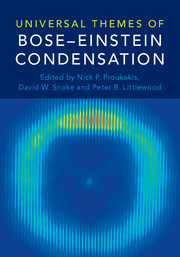Book contents
- Frontmatter
- Contents
- Foreword
- Preface
- Part I Introduction
- Part II General Topics
- Part III Condensates in Atomic Physics
- Editorial Notes
- 13 Probing and Controlling Strongly Correlated Quantum Many-Body Systems Using Ultracold Quantum Gases
- 14 Preparing and Probing Chern Bands with Cold Atoms
- 15 Bose-Einstein Condensates in Artificial Gauge Fields
- 16 Second Sound in Ultracold Atomic Gases
- 17 Quantum Turbulence in Atomic Bose-Einstein Condensates
- 18 Spinor-Dipolar Aspects of Bose-Einstein Condensation
- Part IV Condensates in Condensed Matter Physics
- Part V Condensates in Astrophysics and Cosmology
- Universal Bose-Einstein Condensation Workshop
- Contributors
- Index
- References
17 - Quantum Turbulence in Atomic Bose-Einstein Condensates
from Part III - Condensates in Atomic Physics
Published online by Cambridge University Press: 18 May 2017
- Frontmatter
- Contents
- Foreword
- Preface
- Part I Introduction
- Part II General Topics
- Part III Condensates in Atomic Physics
- Editorial Notes
- 13 Probing and Controlling Strongly Correlated Quantum Many-Body Systems Using Ultracold Quantum Gases
- 14 Preparing and Probing Chern Bands with Cold Atoms
- 15 Bose-Einstein Condensates in Artificial Gauge Fields
- 16 Second Sound in Ultracold Atomic Gases
- 17 Quantum Turbulence in Atomic Bose-Einstein Condensates
- 18 Spinor-Dipolar Aspects of Bose-Einstein Condensation
- Part IV Condensates in Condensed Matter Physics
- Part V Condensates in Astrophysics and Cosmology
- Universal Bose-Einstein Condensation Workshop
- Contributors
- Index
- References
Summary
The past decade has seen atomic Bose-Einstein condensates emerge as a promising prototype system to explore the quantum mechanical form of turbulence, buoyed by a powerful experimental toolbox to control and manipulate the fluid, and the amenity to describe the system from first principles. This chapter presents an overview of this topic, from its history and fundamental motivations, its characteristics and key results to date, and finally to some promising future directions.
A Quantum Storm in a Teacup
A befitting title to this chapter could have been “a quantum storm in a teacup.” The storm refers to a turbulent state of a fluid, teeming with swirls and waves. Quantum refers to the fact that the fluid is not the classical viscous fluid of conventional storms but rather a quantum fluid in which viscosity is absent and the swirls are quantized. The quantum fluid in our story is a quantum-degenerate gas of bosonic atoms, an atomic Bose-Einstein condensate (BEC), formed at less than a millionth of a degree above absolute zero. And finally the teacup refers to the bowl-like potential used to confine the gas; this makes the fluid inherently inhomogeneous and finite-sized. A typical image of our quantum storm in a teacup is shown in Fig. 17.1a.
This chapter reviews quantum turbulence in atomic condensates, tracing its history (Section 17.2), introducing the main theoretical approach (Section 17.3) and the underyling quantum vortices (Section 17.4).We then turn to describing physical characteristics (Section 17.5), the experimental observations to date (Section 17.6), methods of generating turbulence (Section 17.7), and some exciting research directions (Section 17.8) before presenting an outlook (Section 17.9).
Origins
Turbulence refers to a highly agitated, disordered, and nonlinear fluid motion, characterized by the presence of eddies and energy across a range of length and time scales [3]. It occurs ubiquitously in nature, from blood flow and waterways to atmospheres and the interstellar medium, and is of practical importance in many industrial and engineering contexts. Since da Vinci's first scientific study of turbulent flow of water past obstacles, circa 1507, research into turbulence in classical viscous fluids continues with vigor; however, due to its rich complexities, the physical essence and mathematical description of turbulence remain a challenge.
- Type
- Chapter
- Information
- Universal Themes of Bose-Einstein Condensation , pp. 348 - 370Publisher: Cambridge University PressPrint publication year: 2017

